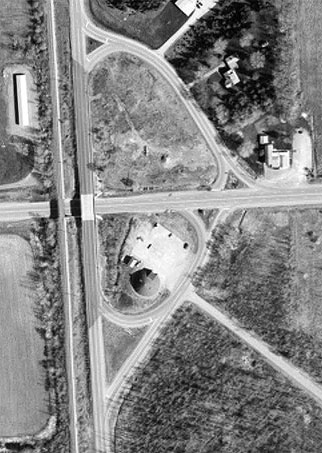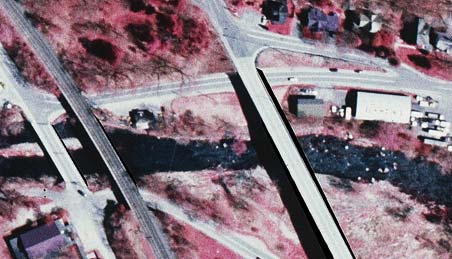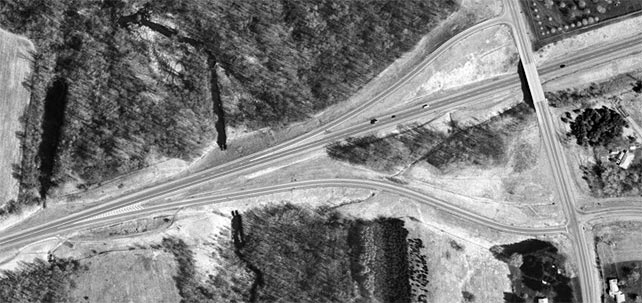
|
Introduction: Interchanges or quasi-interchanges are occasionally encountered in areas far from the major cities and the Interstates. Often, these rural interchanges involve typical undivided, two-lane highways, or there may have been some degree of upgrade towards divided, multi-lane status. There are a few different reasons for the existence of these interchanges. In an earlier age of highway construction, it was often thought best to use connecting ramps at unusually high-volume highway junctions. Modern engineering practices generally favor high-capacity intersections for this purpose. Sometimes the terrain requires the use of ramps, and sometimes interchanges are built in anticipation of eventual upgrading to full freeway status.

|
Orientation: NY 19 runs top to bottom, paralleled closely on the left by the Rochester & Southern Railroad. US 20 runs left to right; the hamlet of Pavilion Center is just off the left side of the photo. Rodgers Road, a town highway, enters from bottom right.
The interchange: This is the largest of several interchanges
along
US 20 through Genesee County, built during the post-Depression years in
one
of New York's highway boom periods. The layout resembles that of a
half-cloverleaf,
except that the ramp legs, where they join NY 19, all carry two-way
traffic,
making this a full, if archaic, interchange. The presence of the
railroad
alongside the highway makes obvious the reason for this design. Note
that
a local road, Rodgers Road, intersects the ramp of the southeast
quadrant,
which also encloses a small highway maintenance facility. Likewise, a
private
driveway intersects the northeastern ramp.
 |
Orientation: NY 97 runs top to bottom at center, bridging Callicoon Creek just upstream of its mouth at the Delaware River. To the left, the Norfolk Southern Railroad and Creamery Street cross over the creek at a lesser height. NY 17B enters at right and climbs the single connecting ramp to terminate at NY 97. The through highway continues beneath NY 97 to become Sullivan CR 133, which runs into the business district of Callicoon.
The interchange: In this case, topography necessitates the use of an interchange. NY 97 crosses Callicoon Creek (as well as two other roads) on a high viaduct, then bypasses the hamlet of Callicoon along the hillside at some elevation. NY 17B, on the other hand, lies in the valley of Callicoon Creek, and CR 133 remains at this level to serve the buisness district. A single, two-way ramp rises steeply from NY 17B to NY 97 (the ramp is actually part of NY 17B, being its western terminus). The ramp configuration seems to favor westbound-to-northbound traffic, although all movements are possible here, as well as at two other junctions of NY 97 with CR 133.

|
Orientation: NY 104 runs left to right, and NY 89 enters at bottom; its northern terminus is at NY 104. The road continues north as a local street into the Village of Wolcott.
The interchange: The NY 104 (formerly US 104) corridor has undergone occasional upgrades since the 1950's. At that time, US 104 was moved off of the Ridge Road onto a new two-lane, high-speed alignment between Union Hill and Sodus. Later, this new highway was extended east to Red Creek, while a full freeway was built for the route through eastern Monroe County. In 1974, US 104 was redesignated NY 104, although it lost none of its importance. Continued improvements brought the aging "new" alignment to a four-lane divided configuration (with intersections) that now extends from Union Hill to Williamson.
Some distance to the east, NY 104 remains a two-lane, undivided highway, with little or no abutting property. At the junction with NY 89, on the southern edge of Wolcott, is a clear indicator of sometime plans to extend the divided highway through Wayne County, perhaps as far as Oswego. The NY 89 overpass is clearly wide enough for a second roadway to be constructed along the south side of the current one, and the right-of-way is already cleared for this. The two ramps are designed to high-speed standards suitable for a true freeway. The eastbound ramp is much longer than the westbound, but with the addition of a second roadway the two ramps would be more symmetrical. Note that this is a partial interchange, with no access to and from the east. At-grade junctions to the east and west provide the missing connections; indeed, it is at these intersections that motorist services and business development are found, not at the interchange shown here.
While the possibility is being kept open, it is unlikely that any actual upgrading will take place in the near future. Although NY 104 is still the primary Rochester-to-Oswego route, traffic counts are not sufficient to warrant construction.